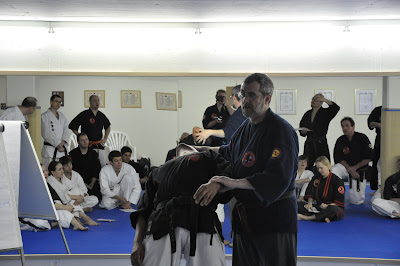
Two friends of mine had the opportunity to train with Taika Oyata-sensei (whom I have never had the pleasure of meeting). They were the only two people in the room who were not from Oyata's group. Everyone else was wearing the characteristic gi of Oyata's Ryu-te school, which consists of a jacket similar to a standard karate jacket, tucked into a a pair of matching nobakama (similar to the ones I mentioned in a previous post, though a bit less traditional). Oyata-sensei walked up to my friends to greet them. He pointed at their black belts, then motioned across his lips, and said, "Lipstick! That's liiip-stiick." What a great sentiment, because it's true. Our belts are for dress-up.
I have noticed that we have made a great business out of rank in the martial arts. What rank someone is becomes of vital importance. "Are you a black belt?" Is always the first question. Our belts are around our waists to make sure everyone knows where we fit in the pecking order, to make sure everyone knows our rank. And dan exams nowadays are nothing more than rights of passage. When a student is allowed to test, the instructor has already decided to promote them. If they make it through the hazing, excuse me, I mean testing process, they will receive the promotion. And if they do not make it through the hazing, I mean testing process, they will still receive the promotion.
When I was 17, it was announced at my dojo that Matayoshi Nakayama-sensei would be visiting from Japan in the fall. Included in his visit would be a dan exam. At that time, I had been a brown belt for about 2 1/2 years. The prospect of testing for black belt (black belt testing occurred only once or twice per year) under the chief instructor of the style was wondrous to me. And so, like other candidates, I worked for 6 months to get ready. I trained a minimum of 10 hours a week in the dojo, working hard on every requirement. As the test date drew near, it became well known at my high school (I was a senior) that I was testing, so all my friends and classmates were wishing me good luck and their best hopes, not to mention the support of my family.
During the test I was nervous but prepared. I performed each of the elements with the confidence of 4 1/2 years of training, the last 6 months of which were devoted specifically to hard preparation for that test. After the test, dojo-mates told me how well I did, and expressed assurances about the outcome. The outcome was announced at a formal dinner in a Japanese restaurant. We were seated on cushions at low tables, in a large tatami covered room (divide-able with sliding doors which had been removed to accommodate the crowd). After the meal, there were various announcements. Nakayama-sensei was given gifts, including an ancient iron tsuba (sword guard). And finally, the rankings were announced.
They began with the names of those who were being awarded provisional black belt rankings (with rank tests so few and far between, this was not uncommon). I remember thinking how I hoped my name would not be among that group, and it wasn't. The announcement continued with the names of those being promoted to 1st dan. As each name was called, there was applause and congratulations. Then, as they moved on to the second dan promotions, it hit me, I had failed my black belt test. All those months of intense training, all that effort, all the assurances of my dojo-mates, all the people(!) who would be asking me if I passed, and I had failed.
Monday at school was awful. "Did you pass?" No. "How'd you do?" I failed. Monday night at the dojo wasn't much better. There I was, back in that brown belt (I hate brown belts, the color of sh*t, because being a brown belt is sh*tty), doing the same things all over again. Punches, kicks, basics, kata, sparring. I had failed my test, and I was clearly doomed to be a brown belt forever. What was the point of even continuing this karate thing?
Since that first dan exam, I have taken other dan exams. And that first test was not the only one I failed, though, clearly, I've passed some as well. But, failing that first test turned out to be incredibly valuable for me. By failing, I knew that passing wasn't a "gimme". I was being held to a standard, and I would either meet that standard or not. And failing forced me to ask myself what I was training for. Was my goal in karate just to attain a black belt? Was it just about that piece of cloth, that status? Was I a dan-chaser, or was I a martial artist?
After 40 years in the martial arts, I mostly agree with Oyata-sensei – lipstick. But, I actually like my belt, though I don't really like my rank. With the amount of talent and skill I see in my many colleagues, I usually feel over-ranked. But I do like my belt. It is tattered and worn, and that says something about my training and my values. The belt is a record of my years. However, I am getting older, and a bit wider in the middle, so now, when I knot my belt, it is starting to look a bit like a bow tie. So, I suppose I need to get a new (read longer) belt, and then wear that one out. Or maybe, I'll just go with nobakama like Oyata-sensei. And then, maybe not, because nobakama make my butt look fat.
Thanks for reading.
Now go train.
CT




































